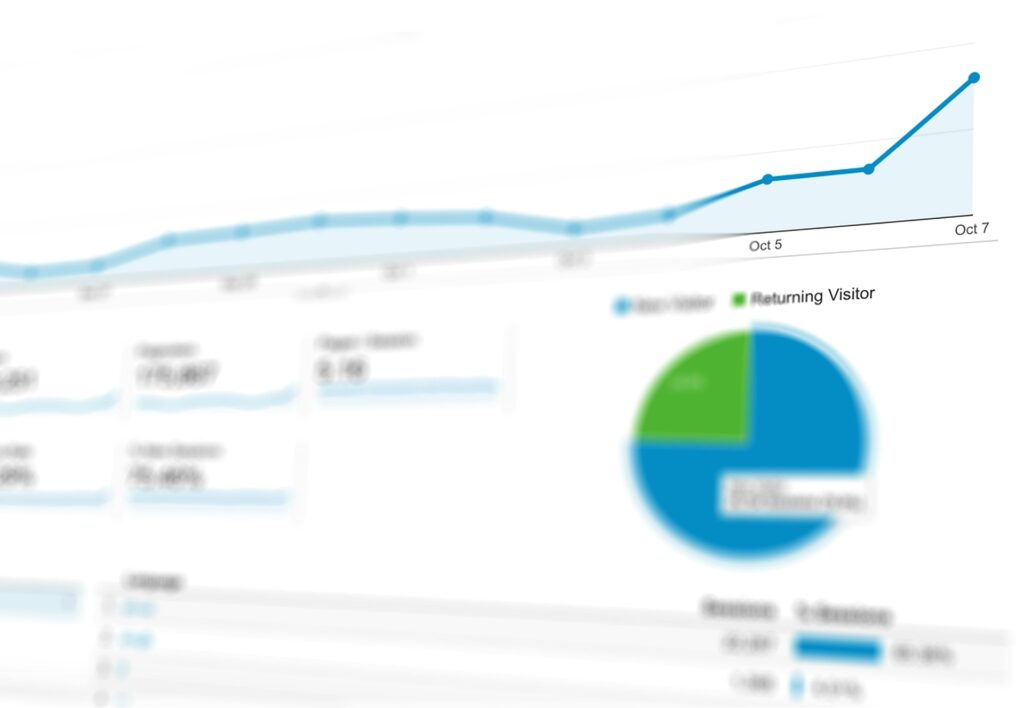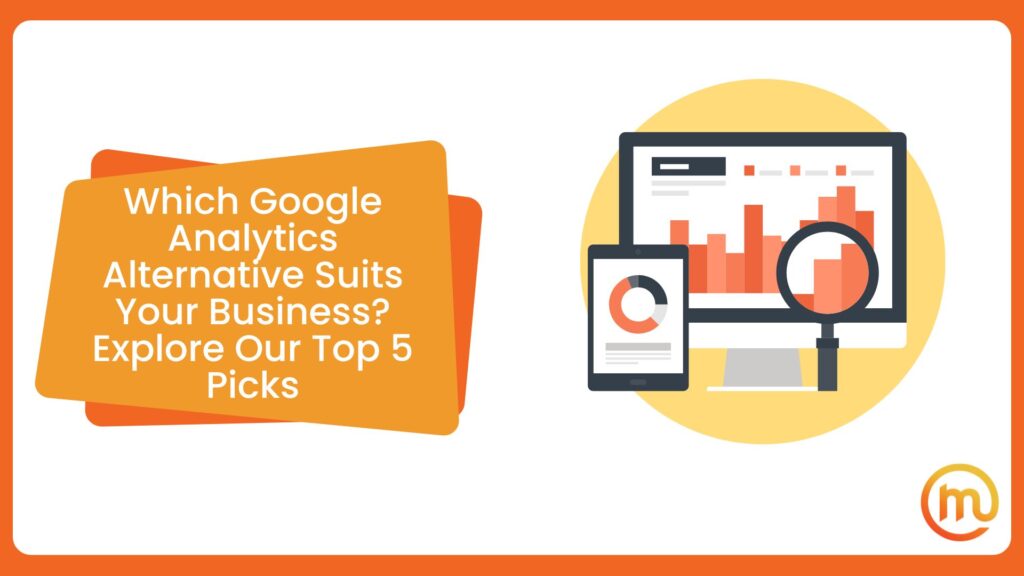Different web analytics apps are designed for one sole purpose – to help you track visitor behavior and measure visits in order to improve the website. Google offers the most popular tool because its features are powerful, and it’s free. Why would you be interested in a Google Analytics alternative then?
Well, not all sites are created the same, and what works for one, may not be the best solution for another. As an experienced marketing agency, we’ve compiled a list of our top picks.
How This Powerful Tool Works
Before we dive into depth of how it works, let’s consider the why. Why would you use Google’s tool or consider the best free Google Analytics alternative? It all starts with our business’s online presence and the success of our website.
In essence, there is no success without users visiting at least one page, engaging with it, and staying. To understand what makes your target audience stay, and what leads to higher bounce rates, you need a web-analyzing tool.
This powerful and free tool works by embedding a tracking code into the website and with it, it collects data from every visitor. This data is then processed into detailed reports accessible via their dashboard. These reports offer insights into traffic sources, user behavior, and website performance metrics like page views and bounce rates.
These reports can further be customized, and you can set goals to track conversions and use segmentation to analyze specific user groups. Additionally, Google’s tool integrates with other services this tech giant offers, and it only further helps SEO efforts and refining digital marketing strategies.
Advantages of Google Analytics
According to Statista, Google continues to hold an 83.5% market share worldwide, and it’s natural that most people turn to their tools as they are readily available. Perhaps it may seem like the biggest advantage of Google’s tool is that it’s free, but it offers several other benefits, too:
- It collects and unifies marketing data in one central place when it’s integrated with the Search Console and Adwords.
- It provides detailed data on web visitor behavior, including clicks and scrolling activities.
- It helps with personalized marketing campaigns and enables you to tailor marketing efforts to the specific needs and preferences of the target audience.
- It shows the sources of web traffic (direct, organic, or paid) and it further helps in the effective allocation of marketing resources.
- This tool also uses data to improve the overall experience of website visitors.
- It allows you to monitor the success of digital marketing objectives and adjust marketing strategies as needed.
All these advantages together will support you in making informed decisions, and help you understand the market position of your business, whether small, medium, or large. They will also enable you to identify competitive advantages swiftly and seize opportunities.
Understand the Disadvantages of This Tool
One of the most significant disadvantages of Google Analytics, especially for companies that operate in Europe, is related to privacy concerns. The tool collects personal data such as location information and tracks web cookies, which can sometimes be sufficient to identify individuals. More importantly, this data is then stored on Google’s US-based servers, which then subjects it to US surveillance laws.
This storage practice conflicts with Europe’s General Data Protection Regulation (GDPR). This regulation is designed to protect the privacy of European residents. US laws, including the Foreign Intelligence Act of 1978 and Executive Order 12333, permit extensive surveillance of non-Americans. Keep in mind that the website owners who target users inside Europe must comply with GDPR. Non-compliance could potentially lead to fines of up to €20 million or 4% of global revenue, whichever is higher.
Google Analytics 4 and Its Issues
However, some other issues emerged with Google Analytics 4. Many a user have reported several difficulties with the tech giant’s newest version of the tool. Although it does offer some great features, here are some not-so-flattering things about it:
- It isn’t even easy to set up, and this goes for the demo version, too. You know something’s amiss when you need to consult external sources and YouTube tutorials just to set things up.
- The second issue is that you weren’t really consulted about whether you wanted to transition to the new version. It’s either that, or you lose all current data.
- Their technical terms are not found in other tools, and even SEO professionals may find it troublesome to grasp some of the features. That means you will need additional training.
The stakes are obviously high, so let’s consider an alternative to Google Analytics. Each comes with its pros and cons, so let’s deep dive into their features so you can choose what’s best for your business.

Our Pick No.1 – Matomo
Matomo, known to some by its previous name Piwik, is an open-source analytics tool, known for its focus on privacy. It allows users to track website traffic and how visitors interact with their site. One of the main advantages of Matomo is that it gives users the option to host the software on their own servers, and it provides them with full control over data privacy and security.
Alternatively, users can also opt for Matomo Cloud, which stores data safely within Europe, so it complies with the General Data Protection Regulation (GDPR). Additionally, Matomo also meets other privacy standards like the California Consumer Privacy Act (CCPA).
The Pros and Cons of Using Matomo
If you’re looking for a tool that prioritizes privacy and transparency, then Matomo is the right pick for you. Here are the most important benefits of this tool:
- Users keep full control over their data, which enhances security and simplifies compliance with data privacy regulations.
- Matomo analyzes all collected data to provide accurate web analytics reports and actionable insights. This helps avoid the common issue of data sampling inaccuracies.
- Google Analytics Import feature allows users to import historical data right from Google’s tool into Matomo while preserving past efforts.
- As an open-source tool, Matomo’s source code is available for review. This can be used to make sure there are no hidden vulnerabilities.
While Matomo offers several benefits, it also comes with several limitations. The tool can be slow when processing large data sets, as it does not sample data when preparing reports and insights. This can lead to delays in data analysis. Additionally, the user interface is considered cluttered, as it features multiple settings that can be overwhelming for first-time users. And in the end, it does not integrate with popular campaign tools such as Google Ads.

Our Pick No.2 – Adobe Analytics
Our SEO agency presents pick number 2 – Adobe Analytics. It is a cloud-based, enterprise-level analytics tool that provides functionalities similar to Google Analytics but with advanced capabilities. One of the most prominent features of this tool is its use of artificial intelligence and machine learning. With these technologies put to use, Adobe’s tool can generate in-depth reports and engage in predictive modeling.
It uses historical data about customer journeys, analyzes it, and identifies patterns to predict the future actions of web visitors. Businesses can take advantage of these predictions to better allocate resources, set priorities, and plan their digital marketing campaigns more effectively.
The Pros and Cons of Using Adobe Analytics
As an organic SEO agency, we can confirm that Adobe Analytics is a sophisticated web analytics platform. It offers several advantages for businesses that want to get to the bottom of visitor behavior. Here are some of the key benefits of this tool:
- It provides data visualization tools that allow users to graphically represent trends and patterns. This makes complex data much easier to understand.
- This tool possesses all the functionalities of Google Analytics, but in addition, it also includes advanced features such as predictive modeling.
- The platform offers in-depth insight into the paths that visitors take through your website.
While this is by all means a powerful tool, it also comes with some notable drawbacks. First of all, it’s costly, as it offers only paid plans that can be a significant investment for some businesses. Additionally, it’s a complex platform that requires a considerable amount of technical knowledge to be used effectively. Especially new users can find that it’s difficult to use without expert support.

Our Pick No.3 – Mixpanel
Known for a more versatile approach, Mixpanel is a product analytics tool designed to delve deeper than simple traffic measurement. It focuses on analyzing real-time data to understand how and why visitors engage with, convert on, and continue to use your website. One of Mixpanel’s biggest strengths is its cross-platform capability. Surprisingly, it works effortlessly across web interfaces, mobile apps, and smart devices.
On top of that, this tool supports features such as A/B testing, audience segmentation, and custom event tracking. It makes it the perfect tool for refining marketing strategies across platforms.
The Pros and Cons of Using Mixpanel
Mixpanel is a great analytics alternative, and it comes with several notable advantages that make it appealing to users. Here are some key benefits:
- It allows you to track user behavior as they navigate the site, and it provides insight into how exactly they interact with it.
- You can tailor your Mixpanel dashboard to fit specific needs. For example, you can set up custom metrics to measure things like audience growth and customer retention and get more targeted insights.
While this tool is rich with features, it does have its drawbacks. One significant limitation is that its reports, which are based on sampled data, do not offer 100% precision. On top of it, it has a steep learning curve, and it takes some time and effort to fully understand and use all functionalities. It makes it difficult for new users to quickly integrate into their workflow.

Our Pick No.4 – Clicky
Clicky is recognized as a privacy-friendly alternative. And because its design is targeted towards strong privacy, it also sticks to GDPR compliance by not collecting personal data or tracking cookies. This tool offers basic tracking capabilities, including metrics like monthly page views, visitor counts, and traffic sources.
One of its most notable features is heatmap tracking which provides a visual representation of where visitors interact most frequently on a webpage. On top of that, it supports real-time analytics for observing and analyzing a visitor’s journey on your website as it happens.
The Pros and Cons of Using Clicky
If you prioritize real-time data and privacy, you’ll be happy to know Clicky also comes with some other advantages. But here are all the benefits of this tool:
- This tool allows you to gain instant access to data as user interactions occur on your site so you can have immediate insights and responses.
- With Clicky, you can avoid legal complications related to GDPR non-compliance, as it does not collect personal data or track cookies.
- Clicky’s heatmap feature visually shows where visitors click on your site to give you a clear understanding of user engagement.
- This tool offers a 21-day free trial on premium plans, which gives you full access to all features. In this period, you can evaluate the tool’s capabilities and determine if the premium features suit your needs before making a financial commitment.
This tool also comes with some limitations – in fact, the free version offers significantly restricted features. For example, users cannot access heatmaps, manage multiple dashboards, or conduct A/B testing, which are available only in paid plans.
Clicky is also only designed for web use, and it lacks the broader device compatibility found in other tools. Users have also reported limited customization options because the platform does not allow much flexibility to tailor the interface or reports. Its limitations also lie in integration with other tools, which makes it less effective than other options.

Our Pick No.5 – Heap
Heap is an analytics platform that helps product and professional SEO agency teams make data-driven decisions. It analyzes complete datasets to uncover hidden insights and help you fully understand user behavior. Additionally, Heap accelerates time-to-market, increases the impact of product and business initiatives, and improves user retention at all stages.
It’s designed for easy use and to simplify the analytics process for websites, mobile applications, and cloud services. It allows you to track user interactions without the need for coding or extensive setup, so it’s accessible for users with limited technical skills.
The Pros and Cons of Using Heap
Besides its user-friendliness and intuitive interface, Heap offers a range of other advantages that make it a popular choice for businesses that want to refine their digital strategies. Here are its benefits:
- It automatically captures all event data with a single JavaScript snippet.
- Heap Illuminate is a feature that proactively surfaces optimization opportunities as it analyzes related events before you even remember to check them.
- It offers Session Replays and Heatmaps as part of its suite.
- It provides easy-to-use templates and the ability to generate real-time reports.
While it may seem like a perfect alternative, Heap does have some areas that need improvement. The onboarding process for new users can be complex, which might delay effective implementation. Additionally, to fully understand and use all its features, users often require extensive training. This can prove to be a big downside for teams with limited time or resources, as it adds a step before they can use the tool to its full potential.

Choose the Google Analytics Alternative and Hire the Best SEO Agency
As you’ve seen, diving deep into analytics can only improve your online presence and help you refine digital marketing strategies. However, no matter how user-friendly a tool you’ve chosen, it’s easier with some expert guidance on the best practices. That’s why investing in professional SEO marketing services is your best bet.
Partnering up with an advertising agency like our Made Online team can be highly beneficial to your ROI. Why? Because we know all things marketing. And above all, we specialize in using different kinds of analytics to enhance your marketing efforts, so no campaign will ever again be in vain. Contact Made Online today to boost your strategies and let your online presence shine.

